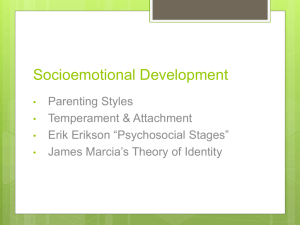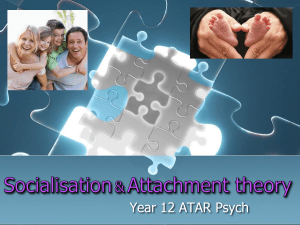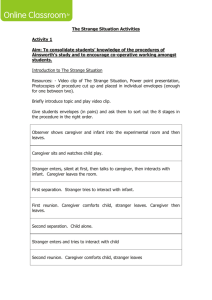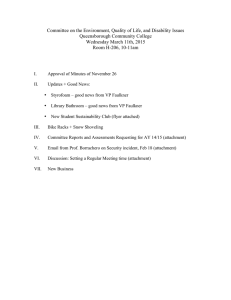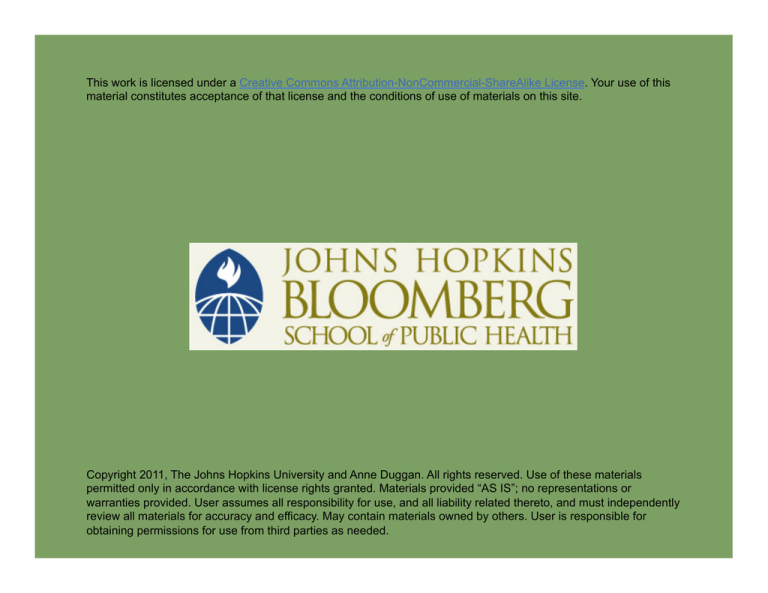
This work is licensed under a Creative Commons Attribution-NonCommercial-ShareAlike License. Your use of this
material constitutes acceptance of that license and the conditions of use of materials on this site.
Copyright 2011, The Johns Hopkins University and Anne Duggan. All rights reserved. Use of these materials
permitted only in accordance with license rights granted. Materials provided “AS IS”; no representations or
warranties provided. User assumes all responsibility for use, and all liability related thereto, and must independently
review all materials for accuracy and efficacy. May contain materials owned by others. User is responsible for
obtaining permissions for use from third parties as needed.
Attachment Theory
and Attachment-Based Interventions
Anne Duggan, ScD
Johns Hopkins University
Outline for Today
Early childhood tasks and social fields
Attachment theory basics
Measurement of attachment
Intergenerational transmission
Outcomes
Approaches to intervention
3
Section A
Early Childhood Social Fields and Tasks
Early Childhood Social Fields and Tasks
Who/what influences early development?
In what domains?
5
Social Fields across the Life Span
6
Early Development: Influences and Domains
7
Attachment Theory Basics
Early childhood tasks and social fields
Attachment theory basics
- Behavioral systems
- Basic tenets
- As applied to parenting
8
Behavioral Systems
Exploratory system
Fear system
Attachment system
9
John Bowlby’s Attachment Theory—1
Children need their primary caregiver(s) to be:
- A secure base for exploration
- A safe haven for protection
10
Circle of Security
Source: Circle of Security® http://www.circleofsecurity.net/. All Rights Reserved.
11
John Bowlby’s Attachment Theory—2
Children’s perceptions of their caregiver form the basis for “internal
working models”:
- Of the self
- Of the caregiver
- Of others
12
John Bowlby’s Attachment Theory—3
As individuals grow to adulthood,
- These internal working models influence their interpersonal
behavior
13
Attachment Theory as Applied to Parenting
Internal working models shape …
- Parents’ interpretation of their children’s needs
- Parents’ responses to children’s needs
14
Measurement of Attachment
Early childhood tasks and social fields
Attachment theory basics
Measurement of attachment
- In children
- In adults
Per developmental psychology
Per social psychology
15
Mary Ainsworth’s Strange Situation Procedure
Mary Ainsworth’s “Strange Situation” procedure:
1. Parent and child introduced to room
2. Child allowed to explore
3. Stranger enters, parent leaves
4. Stranger gears behavior to that of child
5. Parent returns, greets/comforts, leaves again
6. Stranger leaves, child is alone
7. Stranger returns, gears behavior to child’s
8. Parent returns, greets/comforts, stranger leaves
16
Mary Ainsworth’s Strange Situation Procedure
Observations of child’s behavior
- Exploratory
- Reactions to parent’s departures and returns
Classification of child’s behavior upon parent’s return
17
Mary Ainsworth’s Strange Situation Procedure
Observed infant behavior
Insecure –
avoidant
Infant is detached on separation, avoids parent on
reunion, engages in displacement exploration that is
devoid of true interest
B
Secure
Infant engages in positive exploration, is upset by
separation but gives a positive response to parent
upon reunion, with a rapid return to exploration
C
Insecure –
resistant/
ambivalent
Infant is preoccupied with parent’s availability. Shows
distress on separation and anger/ambivalence upon
reunion and is difficult to comfort.
A
18
Mary Ainsworth’s Strange Situation Procedure
Expected parent behavior
(not necessarily during procedure)
A
Insecure –
avoidant
Parent is insensitive to infant’s signals and deflects
proximity seeking
B
Secure
Parent is consistently sensitive and responsive to
infant’s signals
C
Insecure –
resistant/
ambivalent
Parent is inconsistent in response to infant. May vary
between insensitive and intrusive.
19

